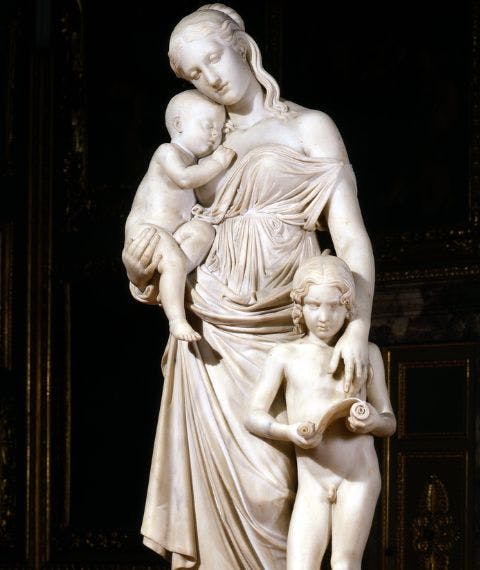Charity
Lorenzo Bartolini (Savignano, Prato 1777 - Firenze 1850)
On the roll:
DILIGES DOMINUM DEUM TUUM, EX TOTO CORDE TUO / ET IN TOTA ANIMA TUA ET / IN TOTA MENTE TUA ET PRO / XIMUM TUUM SICUT T[E]I[PSUM]
The statue was intended to decorate the chapel interior inside the magnificent Villa del Poggio Imperiale. In a plea sent to the Grand Duke in September 1820, the artist Lorenzo Bartolini wrote that he had just defined the composition, based on three figures. However, it will be necessary to wait until the middle of 1822 for the completion of the plaster model. Two years later Pietro Giordani in his article in "Anthology", published an engraving of the work praising its composition. We know, however, that even in 1835 the group was still in Bartolini's studio: Grand Duke Leopold II had gone there to appreciate its quality. In the late spring of 1836 Bartolini's work was brought to Pitti, and placed on the ground floor, in the so-called Private Audience Room, where it has been present since June of that year. In 1853, three years after the death of author, it was already planned to move it to the Palatine Gallery. Although everything had already been prepared, for undocumented reasons, the transfer did not take place and the sculpture remained on the ground floor for a few more years. Only between 20 and 22 July 1861 did Charity find its new location in the Sala dell’Iliade, where it still resides today.
It is, to use the words of the author himself, a "political sculpture". In fact, as early as the 1930s, the name of "educator" began to spread to indicate the marble group. This is because it was defined by Gabriele Pepe in his letter to Gino Capponi, and because an engraving taken from the group was featured on the title page of Raffaello Lambruschini's magazine "L’educatore".
In addition, the inclusion of the child withdrawn and forced to study by his mother, also provided for the intellectual education of the offspring, profoundly renewed the traditional iconography of Charity. In fact, she meant to allude to the Lorraine paternal politics attentive to the needs of the subjects, both material and spiritual. Bartolini also intended to emphasize those evangelical values of charity, as demonstrated by the inscription on the scroll held by the child on the left of the woman: the mother's teaching was aimed at total love for God.
The composition reveals an intense search for the naturality, tempered only by the passionate study of Renaissance specimens, thanks to which the sculptor was able to create a work whose height and severity of the ethical meanings expressed, merged with the compositional harmony.
Spalletti Ettore, "La Carità educatrice di Lorenzo Bartolini", in "Palazzo Pitti. La reggia rivelata", Giunti Editore S.p.A., Firenze-Milano 2003, pp. 210-227.
